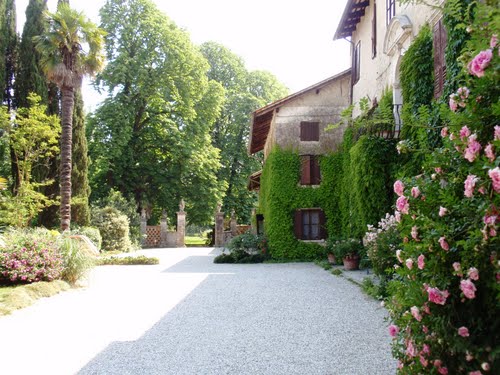
Strassoldo di Sotto Castle
This post is also available in:
 Italiano (Italian)
Italiano (Italian)
Along with Castello di Sopra, this manor should date back to 1035, built by Count Voldarico from Germany. The latter was authorized by the Empire to build such a majestic abode on the main northern road. The actual name of the castle comes from the two German nouns “Strasse” (“road”) and “Aue” (“Island”). It is one of the few castles in Friuli still inhabited by the family who built it. The manor came to life around a massive defensive tower, also used a courthouse. Next to it, other buildings were erected like the “Domus Magna” (“Big house”), protected by the battled walls and fitted with a cuspidate portal of the late XVI century, also known as “Pusterla”.
Nowadays, the tower is gone and only a part of the battled walls can still be seen.
In the XIII century, local settlers built the village of “Borgo Nuovo”, west of the Imbruino River. One of the two original defence towers with portals still stands – although it has lost its archway over time; it is called “Porta Cisis”.
In 1575, the little church dedicated to Saint Mark was built next to the “Domus Magna”.
In the first half of the XVIII century, the castle underwent some major restoration which reshaped the whole complex to its current appearance.
The Park
The green area of Strassoldo is made of four main elements: the park of Castello di Sotto – including water games, “Prato della Cancelleria” (“lawn of the Chancellery”), the park of Castello di Sopra, and the park of Villa Strassoldo Chiasottis, now called Vitas, with its long tree-lined avenue.
The park of Castello di Sotto was born as a result of a major construction work carried out in the first half of the XVIII century, mostly by Nicolò Francesco Strassoldo, on a vast area starting from the southern moat of the castle up to the confluence of the two rivers from Cavanis.
Several springs were interred, sewers were built to drain the water, and a large fishpond with a rectangular island was connected to the open springs on the bottom; wells and fountains were added along with benches carved in the stone and statues with mythological subjects. Last but not least, the banks were consolidated thoroughly managing the water coming out of the fishponds.
In the first half of the XVII century, some major renovation works were made.
The park layout appeared quite formal, according to fashion and taste of that time. The garden was crossed by three vertical and two horizontal paths and fitted with an outer walkway so as to create nine flower beds, with circular intersections.
On the edge of the fishpond obtained from the southern moat of the castle ran a tree-lined avenue connecting the two gates leading to Borgo Nuovo and the Brolo towards the countryside – the latter, called “Natocco”, featured a door surmounted by two stone pumpkins.
Around the rectangular fishpond ran a double series of modelled hedges, the first in boxwood and the second, quite higher, made of hornbeams. The so-called “Isoletta” was surrounded by a box hedge and had an entrance made with hornbeams standing next to a stone bridge. On this little island, there was a secret garden, with four flowerbeds and four walkways converging to a gloriette in the middle. The garden was full of ornamental plants, flowers and fruit. It featured some species of ancient roses, which are still visible and have probably been preserved in their original layout.
The green area in front of the palace withstood the passing of many centuries until the 1900s. Today, it still features an amphitheatre fountain with a lion head, and a beautiful stone door surmounted with six statues on the top: it leads to the central area of the park.
The park has undergone some major changes over time. In the early decades of the nineteenth century, the landscape setting prevailed, considered quite cheap and fashionable. The original layout was then remodelled with an English Garden approach, therefore losing the original walkways, the flower beds and several decorations. What still remains of the original garden includes the box hedges around the islet, the mythological statues, the masonry artefacts, the fountain and the wells.
The “Prato della Cancelleria”, at the intersection between Milaca and a branch of Taglio Rivers, used to have rectangular flower beds delimited vertical, horizontal and external walkways; today it still retains a well surrounded by a stone ring.
In April and October two exclusive market exhibitions are held there: “Flowers, Waters and Castles” in Spring, “Fruits, Waters and Castles” in Autumn.
On both occasions, the manors and the village are decorated with splendid displays of flowers, leaves and fruits.
This post is also available in:
 Italiano (Italian)
Italiano (Italian)
Contatti
Via dei Castelli 22, Strassoldo
0431 93093
info@castellodistrassoldodisotto.it
http://castellodistrassoldo.it
Altre info
Interi euro 8 (1 castello) – euro 14 (2 castelli); bimbi fino a 5 anni non pagano, dai 6 ai 12 anni: euro 4 (1 castello) – euro 6 (2 castelli).
Visite guidate ai Castelli di Strassoldo di Sopra e di Sotto: - nel mese di Dicembre, tutti i sabati e le domeniche alle ore 15 (con luce diurna) e 16.30 (a lume di candela)



